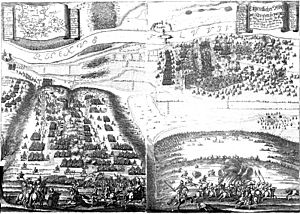Battle of Rheinfelden facts for kids
Quick facts for kids Battle of Rheinfelden |
|||||||
|---|---|---|---|---|---|---|---|
| Part of Thirty Years' War | |||||||
 |
|||||||
|
|||||||
| Belligerents | |||||||
| Commanders and leaders | |||||||
| Strength | |||||||
| 5,000-6,000 men 14 guns |
4,000–7,000 men | ||||||
| Casualties and losses | |||||||
| 400 |
3,000-3,500 500 killed 3,000 captured |
||||||
The Battle of Rheinfelden was an important event during the Thirty Years' War. It actually involved two separate battles near the town of Rheinfelden. One side was a French-allied army led by Bernhard of Saxe-Weimar. The other side was a combined army from Bavaria and the Holy Roman Empire, led by Johann von Werth and Federico Savelli. Bernhard lost the first battle but then surprised his enemies in the second. He managed to defeat and capture both Werth and Savelli.
Why the Battle Happened
After a big defeat for the Swedish army in 1634, Bernhard's army started working for France. They had been pushed back to the west side of the Rhine river. For a while, they mostly stayed in a region called Alsace. Their main job was to help stop an invasion of France in 1636.
In early 1638, the French government told Bernhard to move his army. He had about 6,000 soldiers and 14 cannons. His goal was to find a way to cross the Rhine. He arrived at Rheinfelden, which was an important crossing point. Bernhard planned to surround the town from the south. He also planned to send troops across the river using a ferry at Beuggen. This would allow him to surround the town from the north too. The attack on Rheinfelden was set for March 1st.
To stop Bernhard, the Imperial army moved quickly. This army was led by Count Federico Savelli and General Johann von Werth. They marched through the Black Forest to attack Bernhard's army. Their goal was to help the town of Rheinfelden.
The First Fight
The first part of the Imperial army arrived first. They had moved along the right side of the river. Bernhard's soldiers pushed them back. This gave Bernhard time to get more troops and cannons onto the north side of the river. But when Savelli arrived with the main Imperial army, only half of Bernhard's soldiers had crossed.
Bernhard lined up his army to stop Savelli from reaching the town. Savelli's Imperial army had about 7,000 men. They faced Bernhard's troops. The ground was rough, which made it hard for both armies to stay in formation. Savelli pushed back Bernhard's left side. But on the other side of the field, Bernhard defeated the Imperial right side. It was like a revolving door, with both armies swinging around. Savelli was able to capture the ferry. This cut off Bernhard from his troops on the south side of the river. By the end of the day, the armies were facing each other in the opposite positions from where they started.
The Second Fight
Even though the Imperialists held the battlefield, Bernhard's army hadn't lost too many soldiers. He decided to bring both parts of his army back together. Bernhard avoided the Imperial soldiers. He marched east along the Rhine to a village called Laufenburg. There, he crossed the Rhine and joined his army. Then, Bernhard turned back towards Rheinfelden.
The Imperial army thought Bernhard's forces were defeated and scattered. So, they didn't take many safety measures. Around 7 AM on March 3rd, Savelli's guards were shocked. They saw Bernhard's army coming towards them. The guards quickly went back to Rheinfelden to report this. Savelli and Werth quickly gathered their army. Bernhard's cannons fired three times into the Imperial lines. Then, a final charge broke the Imperial army. Soldiers coming out of Rheinfelden to help were also trapped. They were forced to give up.
Both Savelli and Werth were captured. Bernhard lost only a few soldiers. His opponents lost about 3,500 men. This big victory allowed Bernhard to march north along the Rhine. He then started to surround the city of Breisach.
In Movies
The Battle of Rheinfelden is shown in the 1970 movie The Last Valley. In the movie, a mercenary captain, played by Michael Caine, and his group of fighters find a valley that hasn't been touched by the war. They live there and protect it from other fighting groups. The captain worries that the valley will be destroyed if large armies camp nearby. So, he takes his soldiers to help Bernhard's army capture Rheinfelden. He hopes this will make the armies leave the area. Their mission is successful. But during the fight, the captain is badly hurt, and many of his men are killed.

